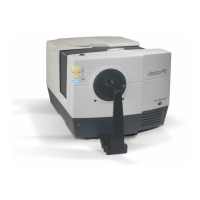UltraScan VIS Supplemental Manual for EasyMatch QC ver 2.0
9
Figure 7. Specular Exclusion Port Open
Automated UV Control
The UltraScan VIS can perform a Ganz-Griesser calibration, by using a 400-nm UV filter. This filter
maintains the proper ratio of the electromagnetic energy in the UV region to that of the visible region.
This improves the agreement of the illumination between different instruments and keeps illumination
constant as the instrument’s lamp ages. This calibration should be used when measuring colors that
fluoresce due to illumination by light in the UV range of the electromagnetic spectrum (such as
optically-brightened whites).
For the Ganz-Griesser calibration, a stable, fluorescent white transfer standard marked with an
assigned Ganz whiteness (normally assigned in reflectance-specular excluded mode) is used to set the
correct illumination conditions. The assigned value is traceable to a four-step cotton white scale
calibrated by the Hohenstein Institute in Germany.
Instructions for using UV control are described in the SENSOR MENU section.
Note: It is important to know what type of fluorescence is involved for the samples being
measured. Some materials fluoresce due to excitation by visible rather than ultraviolet
wavelengths. The UV-absorbing filter does not eliminate this type of fluorescence.
Indicator Lights
The UltraScan VIS’s indicator light feature lets you know what mode of standardization is currently in
use. The top light indicates that power is on. The second light indicates that the specular exclusion port
is open. The third light indicates that small area view is in use, and the bottom light indicates that the
UV cut-off filter is 100% inserted.

